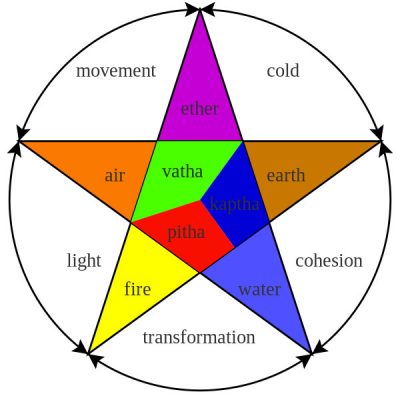
Ayurveda – the science of life
There are many healing traditions in India but without a doubt, Ayurveda is one of the oldest, spanning about 5000 years of unbroken practice. In recent times it has even spread into the West.
Often described as a philosophy of life rather than just a system of medicine, the name actually translates as ‘science of life’. But in this case, ‘science’ has a different meaning than we are used to. It is understood as a divinely revealed philosophy that was conceived in a state of meditation.
According to legend, once upon a time, the wisest Brahmans came together to meditate on the subject of health. It was then that Ayurveda was revealed to them in its entirety. It is both, a philosophy and a ‘science’. Its basic premise is that body, mind and spirit form an inseparable entity, which in turn is connected to everything else in the universe.
Well-being is understood as a state of equilibrium, a perfect balance of inner and outer forces, which can be achieved by means of a balanced lifestyle. Its central teaching is ‘moderation in all things, whether physical, mental or spiritual. Imbalance in any sphere of life will eventually impact all aspects of a person’s ‘body-mind’. Thus, a balanced diet is just as important as are happy thoughts and emotions, or a fulfilled love life.
The Elements
But what does ‘balanced’ mean, exactly? Indeed, a term like that can mean completely different things to different people, depending on their temperament.
Like Chinese medicine, Ayurveda also refers to the elements and regards the manifest world as a dynamic interplay of such elemental forces (fire, air, earth, water, and ether) that shape all aspects of the manifest universe.
The elements have little to do with their physical representations, rather it is the essence of fire, water, air, earth and ether that are implied. It is impossible to grasp these concepts scientifically, they must be intuited within their own system of reference and dense network of correspondences.
Every single person is seen as a part of this vibrant and dynamic web of energies. Likewise, all other natural things (including the healing substances that are used to balance an individual’s ‘vibration rate’). In humans, these elemental forces are thought to combine into three basic constitutional types (temperaments), which are referred to as the three ‘doshas’. All doshas are present in all individuals, but one usually dominates. Occasionally, people can have ‘dual-doshic’ constitutions and display characteristics of two doshas in more or less equal parts.
The three doshas are known as Vata, Pitta, and Kapha:

Vata
Vata is associated with the elements of air and ether. It represents movement and changeability. Vata energy is cold and dry. An individual with an excess of Vata energy may have a tendency towards nervousness and anxiety. They find it hard to sit still and are always on the move. Their minds are quick and active, but the information is also quickly forgotten. Their skin or hair may be dry and brittle and they may suffer from cold hands and feet. Their body frame tends to be light and skinny.
Pitta
Pitta is associated with the elements of fire and water. It represents heat and assimilation and is associated with the metabolic processes. Its hot nature requires plenty of food to fuel metabolism. Because of this inner fire, they often turn grey or lose their hair early. Pitta is also said to be oily, which may present as greasy hair and oily skin. They often have strong body odors. Their memory and thinking processes tend to be sharp. They tend towards perfectionism and often criticize others, or even themselves. They can be dominating and controlling.
Kapha
Kapha is associated with the elements of water and earth. It represents structure and substance. Kapha is associated with the bones and connective tissues. Its quality is heavy and cool. Thus, Kapha types have a heavy body frame and a tendency towards putting on weight. They move and think slowly and can be lethargic. Their skin may feel cool and clammy. They frequently have a sweet tooth. They may be kind and compassionate, but they may also be overly attached and become jealous.
Everybody is constantly subjected to outside influences that may alter their inherent doshic quality so that its expression turns negative. To maintain a state of well-being the doshas need to be balanced with the aid of herbs, nutrition and appropriate mental or physical exercises (e.g. meditation, yoga).
Nutritional Healing
Much of the teachings of Ayurveda is concerned with nutritional healing. Foods are categorized into three basic types:
- Sattva – milk and plant products, mild flavors
- Raja – hot and spicy food, meat
- Tamas – denatured foods, canned food, fast food, alcohol
Which foods an individual should include in their diet is determined by assessing their doshic constitution. An excess of Vata energy is balanced by including foods that are cooked, oily, heavy and warm, and taste sweet, sour, or salty. Refined sugars and yeast should be avoided. Vegetables of the cabbage and potato family are also not recommended. Raw vegetables are ok, but should be marinated, or served with salad dressing. Making proper time for meals (rather than quickly grabbing something on the go) and keeping to regular meal times is also beneficial.
An excess of Pitta energy is balanced by adhering to a predominantly vegetarian diet consisting of plenty of fruits, veggies, and grains. Overly spicy, or acidic foods should be avoided, as should excessive amounts of salt, oil or alcohol.
An excess of Kapha energy can be balanced by a diet consisting of plenty of light, fresh, raw vegetables and fruit. Sweets, creamy foods, nuts, and heavy, starchy foods should be avoided. Spicy foods are beneficial, as they stimulate the metabolism, but sweet, sour and salty foods should be avoided, as should meat, dairy products, and citrus fruits.
Obviously these are only the most rudimentary guidelines. Anybody, who wants to try an Ayurvedic dietary regime, should consult an Ayurvedic practitioner to get recommendations that are tailor-made for them.
The 5 causes of disease
Ayurveda is much more than nutritional healing. It recognizes that different causes of disease call for different sorts of treatment.
Five causes of ill-health are recognized and treated correspondingly:
Accidents:
External injuries, mechanical injuries that call for surgery (broken bones, etc.)
Inflammation
Infections and internal diseases are mostly treated with herbs and other healing substances.
Afflictions of the soul:
Fear, hatred, indolence, jealousy, etc. are treated therapeutically with music, scent (aromatherapy), color therapy, charms, dance, etc.
Natural causes of suffering:
Old age, hunger, etc. are treated with spiritual measures such as meditation, prayer and spiritual practices with the aim of achieving higher levels of consciousness.
Western medicine struggles to come to grips with the often confusing tangle of correspondences and thus, dismisses it as mumbo jumbo, simply because it does not fit neatly into a western scientific model. Some modern Ayurvedic doctors have even tried to translate their system of reference into Western concepts in order to gain more acceptance or to make it easier for western medicine to understand. But Ayurveda continues to evade scientific investigation by the microscopic method, though evidently, it has successfully been used for thousands of years.
Ever since a wave of fascination with Eastern religions swept across Western subcultures, Ayurveda has gained popularity in the West. Ayurvedic nutritionists, health spas, and massage services can now be found in San Francisco, London, or Paris – one no longer has to travel halfway across the world to benefit from these ancient therapies.
However, the question has been raised as to whether a ‘culturally alien’ medical philosophy can be effective, regardless of where and who it is applied to. This argument is certainly one that warrants a pause for consideration.
In some backwaters of India, for example, hygiene is not always adequate. Yet, the administration of injections and Western-style pills may be regarded with such magical awe that they are prescribed excessively and inappropriately, thus producing detrimental and sometimes dangerous results.
Western medicine, although it claims universal superiority over indigenous healing systems, can easily fail in inadequate conditions. Likewise, Ayurvedic medicine in the hands of insufficiently trained practitioners, is also a concern. Access to all the healing substances used in India, may also be difficult. Lifestyle, living conditions and spiritual outlook are completely different in these two different cultures and trying to transpose one onto another is not necessarily practical, even if it is in vogue. However, one should not assume that it would never work.
In India, Ayurveda has been successfully practiced for thousands of years, and evidently, with very good results. But if we want to really understand it deeply we must study its philosophy within its native cultural, philosophical and religious context. To apply only the physical measures is to miss half of its wisdom.



Great content! Super high-quality! Keep it up! 🙂
This blog about Ayurveda – Sacred Earth has helped me a lot, is very
well written.